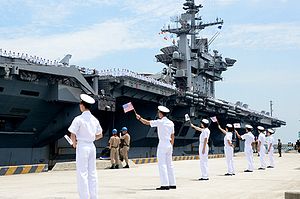The U.S. Navy kicked off a week of naval diplomacy in Northeast Asia on Wednesday.
According to the South Korean-based Yonhap News Agency, the U.S. and South Korean navies began a five-day joint exercise in Seoul’s southwestern seas on Wednesday. According to the report, the drill will involve “two South Korean Navy Aegis ships as well as the aircraft carrier USS George Washington, two American cruisers and one U.S. Aegis ship.”
It actually appears that two U.S. Aegis destroyers are participating in the exercises, however. Besides the carrier itself and its air wing, the George Washington Carrier Strike Group (GWCSG)—which arrived in Busan on Thursday—consists of the Ticonderoga-class guided-missile cruisers USS Antietam (CG 54) and USS Shiloh (CG 67) and the Arleigh Burke-class guided-missile destroyer USS Stethem (DDG 63). However, a photo posted on the U.S. Forces Korea website suggests that the Arleigh Burke-class guided-missile destroyer USS Kidd (DDG 100) has also been on site for the drills.
In any case, the joint exercise itself appears to be comprised of at least three separate drills. The first one is taking place between U.S. and Republic of Korea (ROK) marines in South Korea’s East Sea (the Sea of Japan). The other two are naval drills. The first of these is taking place near the southern port of Mokpo and will be led by the USS George Washington. The second naval drill is taking place in waters north of Jeju Island where South Korea is constructing a major new naval base that some observers believe is aimed at hedging against China’s rising naval power.
Naturally, North Korea has expressed its strident opposition to the joint naval drills in general, and the USS George Washington’s arrival in South Korean waters in particular. As my colleague Ankit reported earlier this month, in an effort to thwart the then-forthcoming exercise, North Korea’s National Defense Commission (NDC), the highest military body in the country, called for a cessation to “all hostile military activities” on the Korean Peninsula. This offer was conditioned on South Korea agreeing to a reduction in military hostilities on the Peninsula, including disallowing U.S. military hardware in South Korea. Unsurprisingly, Seoul rejected the proposal, stating it lacked sincerity.
Indeed, if anything, South Korean President Park Geun-hye seems to be hardening her stance on North Korea. As the U.S.-ROK naval exercise got underway on Wednesday, Park met with Defense Minister Han Min-Koo and top South Korean military commanders. “If there is any provocation [from North Korea],” she said, “I expect you to retaliate strongly in the initial stages.” Park added: “The gravity of the situation does not allow for the least bit of carelessness in maintaining our defense posture.”
The joint U.S.-ROK exercises are not the only naval diplomacy the U.S. and South Korea will be undertaking over the next week. According to Yonhap, on July 21 the two countries will join Japan for a trilateral search and rescue exercise in waters south of Jeju Island. The report indicated that the ships from the GWCSG, as well as two South Korean ships and one Japanese ship, will participate in the two-day trilateral exercise. All three nations will also be sending aircraft to the exercise.
The trilateral exercise will be the first between South Korea and Japan since the latter reinterpreted its constitution to allow for collective self-defense.

































